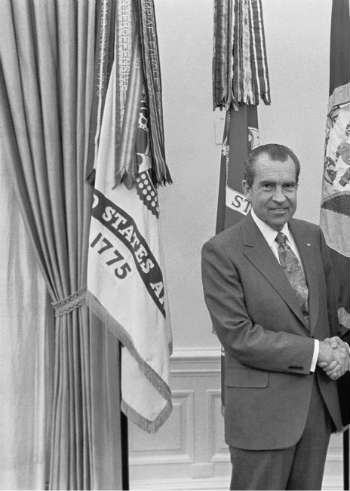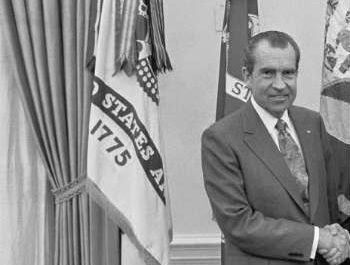President Nixon Releases Additional Watergate Tapes
On April 29, 1974, then-President Richard M. Nixon went on national television and announced the release of additional Watergate Tapes.
Find out about his involvement and how Watergate led to the downfall of a U.S. President.
Brief History Of Watergate
What would eventually become the Watergate scandal began with the keen eye of a security guard making his rounds on June 17, 1972. Frank Wills, a security officer at the Watergate Complex discovered a piece of adhesive tape placed over a lock on a basement door.
After notifying police of a potential burglary, plainclothes police officers responded and began their search of the Democratic National Committee Headquarters. The officers, with guns drawn, took five men by surprise. The men had bugging equipment, burglary tools, cameras and $6,000 cash in consecutively numbered $100 bills in their possession. The U.S. News & World Report lists the men as James W. McCord Jr., Bernard L. Barker, Frank Sturgis, Eugenio R. Martinez and Virgilio R. Gonzalez. McCord was a former member of the CIA. The men were members of the Committee to Re-Elect the President, (CRP).
After detectives took over, two additional men, referred to as “the plumbers” were also arrested. J. Gordon Liddy, former FBI agent, counsel to the Re-election Committee’s finance branch and E. Howard Hunt Jr., former CIA agent, joined the ranks of the others in the investigation.
As the investigation deepened, involvement in the scandal led to Attorney General, Jeb Stuart Magruder and John W. Dean III, White House legal counsel. The break-in, it seemed, was the brainchild of Liddy, who planned and organized the break-in along with Hunt.
Break-ins At Watergate DNC
June 1972 was not the first time the DNC headquarters was burglarized. The initial break-in took place May 28, at which time the burglars installed electronic bugging equipment. The Gerald R. Ford Library & Museum indicates in its Watergate Timeline that on June 19, 1972, the Washington Post reported that John Mitchell, former Attorney General and head of the CRP denied any knowledge of the break-in at Watergate.
On August 1, the Washington Post reported that a check for $25,000 was deposited into a bank account belonging to one of the burglars.
Denials And Cover-Ups
On August 1, 1972, the White House released a statement that White House counsel John Dean conducted an investigation and found out that no-one in the White House was involved.
In September 1972, indictments were handed down, charging the Watergate burglars and “the plumbers” with crimes associated with Watergate.
In October, The Post reported that the FBI linked Watergate to the CRP and its broad activities of political spying and subsequent sabotage.
In spite of the ongoing investigation, Nixon easily won re-election in November 1972. However, the Watergate  investigation was starting to close in on the President of the United States.
investigation was starting to close in on the President of the United States.
The City University of New York Watergate Timeline shows that the Watergate trials began on January 8, 1973. After Hunt pleaded guilty on January 11, Bernard Barker, Sturgis, Martinez, and Gonzalez followed with guilty pleas four days later. On January 30, both Liddy and McCord were convicted on all counts.
President Nixon’s Resignation
As investigators closed in, the White House released a statement denying that Nixon had any prior knowledge of the Watergate break-in. Federal Aviation Administrator Alexander Butterfield revealed the existence of secret tape recording system in the office of President Nixon to Senate Watergate Committee investigators.
CBS News reveals details of other events eventually leading to consideration of impeachment. Nixon initially refused to release the tapes, instead, he released transcripts with some portions edited out. The Supreme Court ordered Nixon to turn over the remaining tapes.
When secret tapes revealed that Nixon ordered that the FBI be told not to go any further with their investigation, that “smoking gun” tape led to Nixon’s resignation announcement on August 8, 1974.







